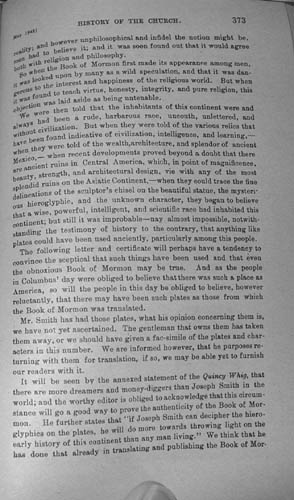Kinderhook plates: Image 2 of 8
![[First]](bw_first.gif)
|
![[Prev]](bw_prev.gif)
|
![[Index]](bw_index.gif)
|
![[Next]](bw_next.gif)
|
![[Last]](bw_last.gif)
|
 |
Joseph Smith, History of the Church, Vol. 5, Ch. 9, p.373 reality; and however unphilosophical and infidel the notion might be. men had to believe it; and it was soon found out that it would agree both with religion and philosophy. So when the Book of Mormon first made its appearance among men, it was looked upon by many as a wild speculation, and that it was dangerous to the interest and happiness of the religious world. But when it was found to teach virtue, honesty, integrity, and pure religion, this objection was laid aside as being untenable. We were then told that the inhabitants of this continent were and always had been a rude, barbarous race, uncouth, unlettered, and without civilization. But when they were told of the various relics that have been found indicative of civilization, intelligence, and learning, when they were told of the wealth, architecture, and splendor of ancient Mexico,— when recent developments proved beyond a doubt that there are ancient ruins in Central America, which, in point of magnificence, beauty, strength, and architectural design, vie with any of the most splendid ruins on the Asiatic Continent,—when they could trace the fine delineations of the sculptor's chisel on the beautiful statue, the mysterious hieroglyphic, and the unknown character, they began to believe that a wise, powerful, intelligent, and scientific race had inhabited this continent; but still it was improbable—nay almost impossible, notwithstanding the testimony of history to the contrary, that anything like plates could have been used anciently, particularly among this people. The following letter and certificate will perhaps have a tendency to convince the sceptical that such things have been used and that even the obnoxious Book of Mormon may be true. And as the people in Columbus' day were obliged to believe that there was such a place as America, so will the people in this day be obliged to believe, however reluctantly, that there may have been such plates as those from which the Book of Mormon was translated. Mr. Smith has had those plates, what his opinion concerning them is, we have not yet ascertained. The gentleman that owns them has taken them away, or we should have given a fac-simile of the plates and characters in this number. We are informed however, that he purposes returning with them for translation, if so, we may be able yet to furnish our readers with it. It will be seen by the annexed statement of the Quincy Whig, that there are more dreamers and money-diggers than Joseph Smith in the world; and the worthy editor is obliged to acknowledge that this circumstance will go a good way to prove the authenticity of the Book of Mormon. He further states that "if Joseph Smith can decipher the hieroglyphics on the plates, he will do more towards throwing light on the early history of this continent than any man living." We think that he has done that already in translating and publishing the Book of |